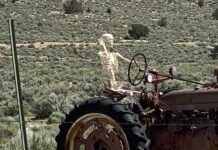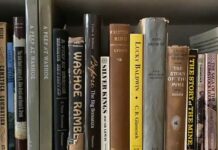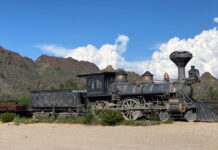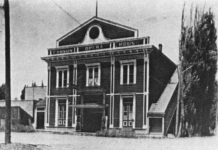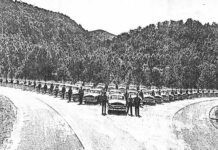by Eddie Ann Miller
“Wabuska” is the Washoe Indian word for “White Grass”. The natives appropriately named this area for the chalky white alkali soil, which dusts everything, including grasses that grow near the hot springs. According to local Indians, the mineral rich, red hills which overlook Wabuska, provided the dye for the red paint used by Wavoka in his Ghost Dance, which he introduced around 1889.
Already established by the time of the Ghost Dance, the Wabuska Bar in Wabuska, Nevada was built in 1881 by Edward Lovejoy. Edward was the son of Elijah Lovejoy, a famous abolitionist and newspaper editor, who was killed by a pro-slavery mob in Alton Illinois in 1837. The elder Lovejoy is considered to be the first martyr of the free press.
Edward was an infant at the time, and was whisked away by his fleeing mother, as the story goes. Thus began a saga which eventually took Edward by ship around Cape Horn, to San Francisco and the California mining towns, to Virginia City, and eventually to Wabuska, Nevada.
Wabuska, at its height, had a school, several saloons, brothels, businesses, and houses. It was a railroad town, and like many towns at the time, many of its buildings were moved from towns that were in decline, such as Virginia City. The Wabuska Bar’s back bar (where bottles are stored), and part of the front bar (where you sit) were moved from a saloon in Virginia City, but no one knows which one.
The building itself is a jigsaw puzzle of several different buildings assembled into one. The front section was the bar, and in its earliest days, a post office, store, barber shop — the original mini-mall. The upstairs was a hotel, and very likely used as a brothel in later years. The back section provided living quarters for the proprietors.
Edward Lovejoy ran this establishment for 10 years until his death in 1891. He is buried in Dayton. I visit his grave from time to time, and tell him news of Wabuska and his bar. After Lovejoy died, a man named Feeney ran the Wabuska bar for, I believe, 30 years or so. His legacy is an huge safe that that bears his name. It was around this time that the place was a “hotel” (and by many indications it was a brothel too). During prohibition, liquor was hidden in a secret room behind a closet under the stairs.
Feeney sold the bar to Mary And Al Veil. The couple raised their children there, as evidenced by the marbles and pieces of a child’s arrowhead collection I found in the dirt. Al Veil ran the bar for many years, and then after his death, his wife Mary took over. She worked well into her eighties, bartending until she was no longer able, and it was widely known that Mary Veil loved the Wabuska Bar. Mary’s nurse claimed that during her final, lengthy hospital stay, Mary had repeatedly talked about going home to Wabuska. She died in the hospital in Yerington.
The bar was dormant for 10 years or so after Mary’s death. Vandals broke in and used a cutting torch on Feeney’s safe in an attempt to get it open. In the mid-90’s, my brother bought the bar, and I took up residence in the back living quarters, and oversaw an extensive interior remodel in preparation for my stint there as live-in bartender. I was immediately taken with the place. It was rough, shoddy, dusty, wild-western and deliciously spooky!
On my second visit to the bulding, I was exploring under the staircase, and jumped back and gasped when I saw what I thought were two huge eyes staring back at me. It turned out to be two old ceramic wire insulators, part of the old electrical system. At that point, I decided to acknowledge that I was a bit uneasy, and to just relax and enjoy any spirits, if they were present. I was actually more scared of transients because there was no way to completely secure the building. The bar is right next to a highway, and there were signs that various hitchhikers had flopped there for the night during its dormancy.
Each day when I arrived to work on the remodel, I would first run my dogs Coach and Nigel through all the rooms. Later, I was joined by a building crew, and we worked for over a year to get the bar ship-shape. Many who saw the finished product said that Mary Veil would have loved it. She had always wished she could afford to fix the place up. But business was slow in the later years.
The town of Wabuska was now “population 5”, and other buildings that had once stood there were hauled off to Yerington to be recycled one more time.The train station which had stood across the road, was taken to the state capital, Carson City to be featured in a park at the Railroad museum. Wabuska had mostly disappeared, a piece at a time. Times were changing, but those who remembered Mary said that they just knew she was still there.
After her death, and during the time the bar was vacant, people had claimed to see her in the window as they drove by. One patron claimed that after the reopening, she saw Mary behind the bar. Mary told this customer to go back behind the bar and help herself. If true, this was a typical “Maryism”, because as she aged, Mary would sit by the woodstove and instruct patrons to pour their own, and leave the money on the till. Myself, I’ve always been sensitive to paranormal occurrences (Pisces). I had an immediate affinity for the bar and for the woman whose photos still lined the wall. I felt like her protegé, and I accepted that Mary was there in many ways. The experience was like “The Shining” as the place really got under my skin.
To this day, I still dwell on it, and am sad that things are no longer done according to my vision. However, to be fair, the current residents have their own appreciation, and I feel that my sadness is due to the level of psychic comfort I drew from the place.
As far as ghostly activity, I experienced a few things. The light over one of the pool tables turned on and off now and then when no one was around. I also found the same light swinging wildly when there was no breeze, nor anyone to give it a push.
During the remodel, there were still lots of items left over from the previous occupants. Initially, I was the only person going to the bar to clean up, and in effect, clear ground for the remodel. I was pretty unprepared for the job in the beginning, and many times found myself looking for an item to make into an impromptu tool. For example, I was taking apart some drawer handles to clean them. I needed a flat head screwdriver to take them off. The first drawer I looked in had just the type and size of screwdriver I needed, but nothing else. Later, I needed some sandpaper to remove the rust from the drawer handles. The first drawer I looked in had a little piece of sandpaper, just perfect for the job, but again, nothing else. This went on for days u il I got wise and brought my own tools and supplies. I always remembered to say, “Thanks Mary”. I truly felt she was helping me get the job done.
Sometimes my needs were a really strange tool, but it was provided every time. An awl to punch a hole… a piece of steel wool… One day, I had to pull up the old carpet in one of the bedrooms. I had always heard that it is common to find newspapers in old houses, sometimes used for insulation. I always knew I would find one too. As I pulled up the carpet, I found an early 1900’s San Francisco Chronicle. I was flabbergasted. I knew it would happen, but was still shocked when it did.
Years later, I found other newspapers, but these were from the WWII era. One was from December 8th, 1941, the day Pearl Harbor was attacked.Many other things happened to me there, but the actual contact with Mary was one I would never forget. It happened during a time when I was trying to sort out a bad relationship with my then boyfriend. It was a slow night. I was alone, watching tv. From nowhere, I felt a hand touch me on top of my head. The hand stroked me from my head all down my back. It was as plain as if someone else was really there. It was a most comforting touch, like a mother silently saying that everything will be okay. It startled me, of course, but I quickly came to grips with it. I didn’t run screaming. Instead, I silently acknowledged the touch like, “Ohhhh okay, I love you too Mary”.
Well, everything did work out for me. Soon, I met the man who would become my husband, and I moved away from Wabuska. My Dad and his wife are the current proprietors of the bar. My visits are short and bittersweet these days. I don’t know if Mary is still around or not. Perhaps an investigation would yield more information. I am curious to know, and would love to go along and say “hi”. If you are experienced in this type of investigation, let me know. Maybe I can arrange something.
Thanks for reading.



